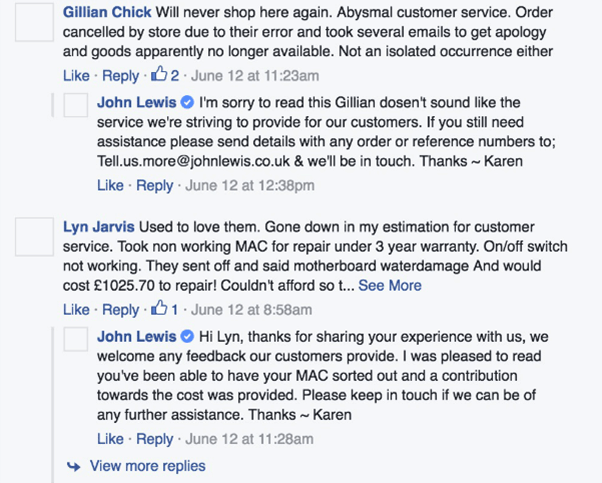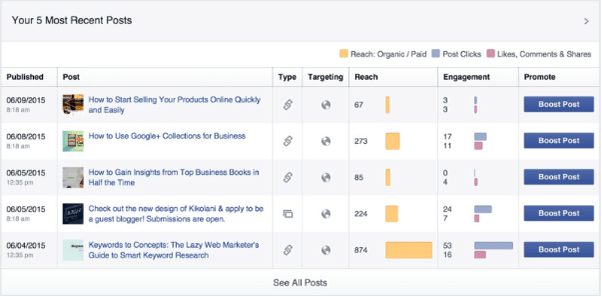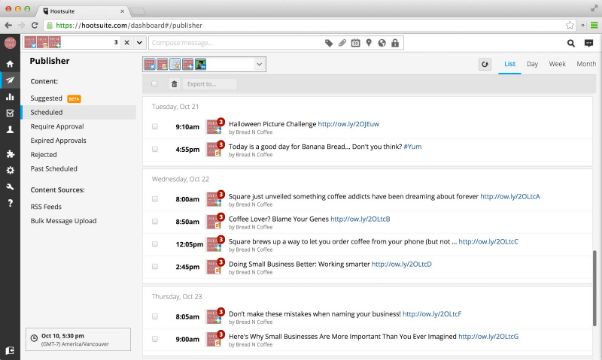
It’s easy to look at big brands on social media and think
“This isn’t so hard”
but while they make it look quite effortless, it isn’t without stress, trial and error. Even without the luxury of a large marketing department, smaller businesses can emulate the success of big brands by following the 17 steps laid out in this article.
Table of Contents
- 1 1. Define Your Goals
- 2 2. Outline Your Content Strategy
- 3 3. Set Marketing Objectives
- 4 4. Know Your Audience
- 5 5. Be on the Same Channels as Your Audience
- 6 6. Separate Strategies for Separate Channels
- 7 7. But Use the Same Language as Your Audience
- 8 8. Know Your Competition
- 9 9. Share Quality Content
- 10 10. Respond to and Engage With Your Audience
- 11 11. Coordinate With all Internal Departments
- 12 12. Have a Content Calendar
- 13 13. Analyse Performance
- 14 14. Have a Unified Look
- 15 15. Know When to Spend Money
- 16 16. Be Consistent
- 17 17. Automate to Simplify
- 18 Conclusion
1. Define Your Goals
Like all other aspects of your business, your presence on social media networks needs to be linked to specific goals. Goals are often defined broadly, but linked to measurable marketing objectives (see below), and they form the basis on which you establish your strategy, objectives and the tactics you intend using. In terms of social success, you need to describe what you want to achieve through your marketing efforts on each social media network you have a presence on. Examples include:
- Brand related – raising awareness of your brand, or reaching new demographics.
- Customer service related – if you are using social media as a customer service platform, your goals would relate to response rates, engagement and even support tickets.
- Lead generation – increasing web traffic, and the ROI on specific campaigns intended to drive conversion.
https://twitter.com/netflix/status/743880722327318530
https://twitter.com/Netflixhelps/status/723351957113434114
Netflix has a two-pronged approach to social media, one is to promote the brand – and obviously attract new customers – while the other is focused on customer service. They keep the two separate by having two Twitter accounts: one purely for entertaining, marketing related posts, and the other to deal with customer queries, and to post about service issues.
2. Outline Your Content Strategy
As with your company website, your efforts on social media should be controlled by a clearly outlined content strategy. As a minimum, your social content strategy should consist of the following:
- A list of all the social media channels your company uses, and who is in charge of each.
- The primary and secondary goals of your social presence, along with the KPIs you will be measuring.
- Mini profiles of who your target audience is, and what you want/need from them, broken down per social media network. Your audience is likely to be different on each channel, but we’ll explain that later.
- Important dates for the full year ahead. These would include holidays, special occasions and any promotions and product launches you already have planned.
Later on you will link this to a detailed content calendar.
3. Set Marketing Objectives
Your goals might be defined in broad terms, but your marketing objectives will be more precise, since they are the specific – and measurable – steps you will be taking to achieve your goals. Your goals might state that your presence on social media is intended to generate more leads, and increase sales, but your marketing objectives will add numbers to those goals, specifying how many leads you hope to generate via social media, and what increase in sales you hope to achieve through your social strategy. Your marketing objectives will also describe the tools and analytics you will use to measure your success. As mentioned previously, it is important that each of your objectives is linked to specific goals, and that timeframes are also attached to each objective – your goals are long-term, but your objectives are short and medium-term stepping stones towards achieving your goals.
4. Know Your Audience
Buyer personas are an important component of any business, helping you ensure you are targeting the right people, in the right places, at the right times, and with the right message. And the more detailed and accurate your personas are, the easier it is to reach both existing, and new customers. This is especially true when it comes to social media, since your audience on each network is likely to be very different, with some skewing to older generations, and others to much younger generations.
5. Be on the Same Channels as Your Audience
It is not necessary to have an active presence on every single social network, only those that appeal to your current (and target) audience, and where they themselves are most active. Remember: the right people, in the right places; everything else is just wasted time.
Discovering what networks your audience is most active on can be a little tricky for smaller businesses, but actually asking your customers can help, along with studying what your competitors are doing on social media (see below).
6. Separate Strategies for Separate Channels
Leading on from the previous point, you will probably also find that audiences on different social networks respond to different types of content, so it is vital that you analyse the performance of each post on all the networks you are active on to establish what content generates the best results. This will help you to refine your strategy, leading to better results on your objectives.
Wendy’s feed on Instagram is completely different to what you will find on their Facebook Page – no memes, just high impact visuals and videos.
7. But Use the Same Language as Your Audience
Like the rest of your content marketing strategy, your social media strategy is an opportunity to present a more human aspect of your brand to customers. Avoid using industry buzzwords and formal language in your social media copy, using a relaxed, almost conversational tone instead – especially when responding to customers on social media. If your language is too formal or stilted, your customers might assume they’re communicating with a bot and not a real person. But if you’re going to occasionally incorporate trending topics and hashtags in your social content, make sure you fully understand the context, and that it relates to your brand in some way, otherwise you risk embarrassing yourself, and alienating your customers.
This beautiful hamulet is all anyone can talk about these days.
A post shared by dennysdiner (@dennysdiner) on
Like Wendy’s, Denny’s content differs across the various social networks, with the content shared on Instagram being kookier than what is shared on Facebook. It is obviously targeting a younger audience on Instagram, and the number of likes and comments show that this strategy definitely works for them.
8. Know Your Competition
Knowing your competition on social media is not that different from knowing your competition in the business world. Identify 3-5 of your primary competitors, and analyse their activity on social media:
- which networks are they using
- what type of content are they posting
- how many followers do they have
- how frequently do they post content, and at what times
- what are their engagement rates: how many likes, shares and comments does each post attract
Knowing this can help you shape your own content strategy, allowing you to incorporate some of their more successful techniques, and even target some of their audience.
In this context, quality is not simply about how polished your content is, it is about the value it adds to the lives of your customers: how it helps them. The greater the value to them, the more likely they are to engage with your content, and pay attention to your future posts. Quality content not only helps build trust, it can also help you grow your audience.
<iframe src=”https://www.facebook.com/plugins/video.php?href=https%3A%2F%2Fwww.facebook.com%2Fwendys%2Fvideos%2F10155426746509489%2F&show_text=1&width=560″ width=”560″ height=”464″ style=”border:none;overflow:hidden” scrolling=”no” frameborder=”0″ allowTransparency=”true” allow=”encrypted-media” allowFullScreen=”true”></iframe>
Wendy’s makes excellent use of their social media presence, and recently they started doing live streams on Facebook, giving their audience an opportunity to ask questions about Wendy’s, and anything else on their mind.
10. Respond to and Engage With Your Audience
Your website is a one-sided communication channel, where you share information with your audience, and try to convert new customers. This is also true for your presence on social media networks, except it should not be one-sided. Social media is an opportunity for you to properly engage with your audience by reacting – and responding – to their comments. Customers see social media not only as a means to learn more about brands and products, but also to initiate a dialogue regarding any problems they are experiencing, and to pose questions. Some brands choose to steer these conversations towards private channels such as direct messaging, email or even telephonic communication, which is good for complex problems that may require personal information in order to resolve. But this should be the exception, and not the norm, especially when your response could help other customers with similar problems.

The John Lewis social team responds to customer comments
As mentioned previously, try to keep the tone light and conversational, and use plain language wherever possible. And don’t forget that your audience’s comments and questions can be used to further shape your social media strategy, and future posts.
11. Coordinate With all Internal Departments
A small business might not have large teams managing different departments, but they would still have individual employees responsible for separate business functions. It is vital that these departments, or individual employees, are involved in every step of your social strategy; not only will they be able to suggest ideas for actual content, but they will also have better knowledge of what goals and objectives they would be able to contribute to. Each department (or employee) will have intimate knowledge of what their internal pains are – what obstacles they face each day – and who their customers are, allowing you to create more detailed buyer personas.
12. Have a Content Calendar
Earlier we covered some steps involved in outlining your content strategy, and one of the documents linked to your content strategy is a content calendar. Aside from listing the days and dates in each month in chronological order, your content calendar should include the following:
- Content description – a brief description of the content that will be posted, including what the objective/goal is.
- Time – this only needs to state whether it will be posted in the morning, afternoon, or in the evening.
- Type – is it a link, text, image and text, video, etc.
- KPI – how are you going to measure the success of each post? Clicks, views, shares, comments, etc.
- Result – the actual KPI result, updated after the content is posted.
Populate your content calendar as far in advance as you can manage, but never less than a month in advance. This gives you sufficient time to create any media that is needed – graphics, videos, etc. – and by planning ahead, you also reduce any stress associated with coming up with content to post, and ensuring that it addresses specific objectives. It also assists with automating your social posting, as discussed later in this article.
13. Analyse Performance
Analysing the performance of each post, on each channel, serves a dual purpose:
- It allows you to track your progress towards achieving your objectives, and
- It allows you to see what types of posts perform best.
There are many paid solutions for analysing your performance, but before you start investigating them, get to know the free analytics tools that are included with each channel.

Image source: SproutSocial
Some of the key performance indicators can be recorded on your content calendar, while others will need to be plotted separately.
The key metrics to measure include:
- Number of followers, including growth.
- Reach, which is different to the number of followers you have. Each post will only reach a fraction of your audience, and even then, not all of them will actually see, or pay attention to the post. Analyse reach in relation to the time each post is made to help determine the optimal day and time for sharing updates on different social channels.
- Engagement, which is first measured in terms of the number of likes, shares and comments each post attracts, and then in terms of referrals and conversions – if any of the posts include a link back to your website, how many people follow the link, and how many of them convert?
- If you are posting videos, then you would also need to measure how many times each video is viewed.
- Post type performance: a comparative measure of how each post type performs in relation to other types.
14. Have a Unified Look
We previously discussed having separate strategies for each social network you are on, but this needs to be managed carefully to ensure that your brand identity remains consistent. Even if the type of content you share is very different on each network – as is the case with Denny’s – your audience should never have any doubt that it is your official account.

Denny’s Facebook & Twitter profiles are identical
From having the same handle/username on each network, to using the same profile photo, and largely similar bio’s, a consistent brand identity is important. And while it isn’t essential that all images you post include branding, your videos should.
15. Know When to Spend Money
Creating a presence on social media doesn’t need to cost you anything apart from some time and effort, but being willing to spend a bit of money – and knowing when to spend it – can only benefit you and your business more. The growth in the freelance economy means you don’t need to hire a full-time designer to get great looking content, and finding freelance photographers, videographers and designers is incredibly easy, and much more affordable than a full-time employee. Not every single post to your social networks has to be professionally designed, but it can make things easier for you, while also helping to ensure your brand identity does not suffer.
Another part of your social presence that can benefit from a willingness to spend money is exposure and reach, in the form of advertising on the various networks. Instagram, Twitter and Facebook all offer advertising to a global audience, whilePinterest is currently only available in selected countries. They all offer you an opportunity to not only be seen by more of your existing audience, but also to reach people who aren’t following you yet. Each campaign is highly customisable, right down to how much you are willing to spend.
16. Be Consistent
Consistency is not only about having a unified look, but also about posting regularly. Ideally you would be posting every day, but this is more challenging for small businesses, so ensure that you consistently post on the same days each week, at roughly the same time. This can be extended further by also posting specific types of content on certain days, so Monday’s see you posting helper videos, and Wednesday’s posting image links that drive traffic to your website.
17. Automate to Simplify
The final step to social success is automating your posts, which is only possible if you have taken the time to compile and populate a content calendar.

Image source: Hootsuite
Knowing what content you are going to post, and when you are going to post it, allows you to use tools such as Buffer or Hootsuite to schedule everything in advance, with the added benefit of enhanced analytics offered by both tools. However, automation is only meant to save you from having to remember to post, they do not take away the responsibility you have to actively monitor each of your social channels, and to respond to customer queries and comments.
Conclusion
The path to social success begins with knowing what you want to achieve, and outlining the processes you are going to follow. And part of this is awareness of your audience, and your competition.
And while there are no shortcuts to having a great social media presence, by implementing a clear strategy, with specific objectives, you are more likely to achieve success. And with a lot less stress.

0 thoughts on “Successful Social Media Marketing in 17 Steps”